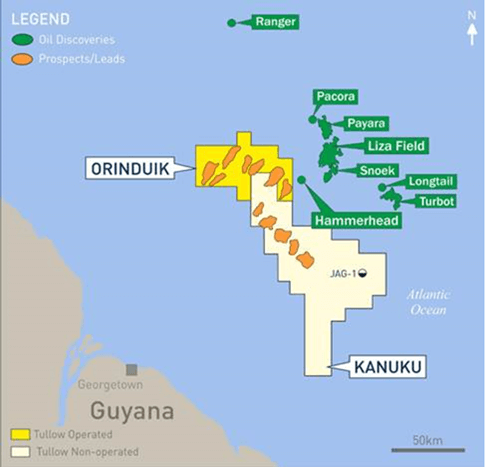As it prepares to drill its first well in its offshore Orinduik Block in the last quarter of 2019, Eco Atlantic yesterday said that an independent technical report on its hydrocarbon assets estimates that there is nearly three billion barrels of oil in the block.
According to the company, a Competent Persons Report, conducted by the independent assessor Gustavson Associates, states that the oil is believed to be in 10 prospects within the block.
“Eco…is delighted to announce that Gustavson Associates LLC of Boulder, Colorado has prepared a Competent Persons Report (“CPR”) for the AIM Market of the London Stock Exchange along with a NI 51-101 report for the TSX VentureExchange. This CPR is the first on Eco Atlantic’s Orinduik Block, Offshore Guyana. The Company announces Gross P50 (Best Estimate) 2,913.3 MMBOE and Net (40%) 1,165.3MMBOE, identified across a total of 10 Leads on the Orinduik Block” a statement yesterday said.
“Today’s CPR confirms the high prospectivity of our Orinduik Block. We are delighted by the identification of at least ten exploration leads with close to 3 billion barrels of recoverable oil potential, confirmed by Gustavson,” it added.
Eco Atlantic’s projections comes on the heels of ExxonMobil’s major oil find offshore in 2015 and another discovery in August this year.
The latest find, Hammerhead-1 is situated approximately 13 miles (21 kilometers) southwest of the Liza-1 well and follows previous discoveries on the Stabroek Block at Liza, Liza Deep, Payara, Snoek, Turbot, Ranger, Pacora and Longtail. Those prior discoveries led to the announcement of an estimated recoverable resource of more than 4 billion oil-equivalent barrels discovered to date, and the potential for up to five floating production, storage and offloading (FPSO) vessels producing more than 750,000 barrels per day by 2025.
The Orinduik Block sees Eco with a 40% interest while the remainder 60% is owned by operator Tullow Oil. However, in a farming-in arrangement, France’s Total has an option to buy 25 percent of Eco’s share. Total will have up to 120 days to exercise that option.
Eco’s co-founder and Chief Operations Officer, Colin Kinley, was upbeat about the report and made and said that it is also important for the people of Guyana.
“We are very pleased with the current interpretation work that has been completed at Tullow, Gustavson and within Eco and have a great deal of confidence in our joint efforts to date. The additional discoveries on Exxon’s Stabroek Block, including the most recent Hammerhead-1 that is on our 3D survey, enables us to see the formations ramp up onto Orinduik. These have greatly helped us to further understand the play. Ten key leads have been identified on Orinduik to date. The partners will carefully consider in the coming months the prioritization of the leads for drilling as we continue work on the drilling engineering and the environmental permitting,” he said.
“We have identified the potential for close to 2.5 billion barrels of recoverable oil and 2.45 trillion cubic feet (tcf) of associated gas. These are very meaningful numbers for all the partners and most importantly the people of Guyana. Three of the targets we have identified have estimated Probability of Success calculated at 22.4% at this stage. This risking is extremely good for any company on a single lead, let alone three. As noted in the previous announcement, we continue to de-risk the play and are approaching this with a conservative and focused approach. As our partner Tullow announced last week, we are planning to drill our first well early Q3 2019 and we are in the process of permitting and engineering in parallel with continuing geophysical and geological assessments,” he added.
Under the agreement the APNU+AFC government signed with Tullow Guyana B.V. and Eco (Atlantic) Oil and Gas Incorporated, in January of 2016, Guyana will receive a 1% royalty and a greater share of profits with increased production.
The 69-page agreement, commits the two contractors to pay a royalty of 1%, while profits will be shared on a sliding scale.
Article 11 of agreement, which addresses “Cost Recovery and Production Sharing,” explains that the government will receive 50% of profits earned from the first 25,000 barrels of oil per day, 52.5% from the next25,000 barrels, 55% from the next 15,000 barrels, 57.5% from the next 15,000 barrels and 60% for production above 80,000 barrels.
Under its much criticized agreement with Exxon, Guyana is to earn a 2% royalty and 50% of the profits after production begins.
Another major difference appears in Article 5 of the Tullow/Eco agreement, which notes that the contractor is not required to relinquish any area of the contract at the end of the initial petroleum prospecting licence if they decide to renew. A relinquishment of 25% of contract area is required for all renewals after the first.
Following an initial contract period of four years, the agreement allows for two renewals for a period of three years each.
Minor differences include the absence of a signature bonus and differences in rental fee. Only Exxon has provided a US$18 million signing bonus. The rental charges for 1,776 sq. kilometres block referenced in the Tullow/Eco agreement is US$40,000 and the company will pay US$25,000 annually for the training of locals.





